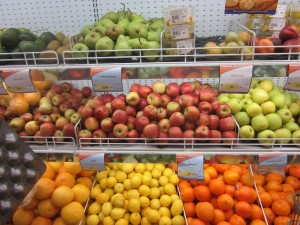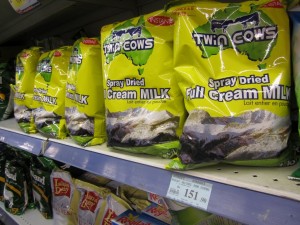- Insufficient grain resources
- Fluctuating Energy prices
- Population trends
- Rapid Economic Growth
- Extreme weather
 |
| Biscuits |
 |
| Rice |
 |
| Fruits |
 |
| Bread |
 |
| Canned Food |
 |
| Cereals |
 |
| Canned Fish |
 |
| Milk (powder) |
 |
| Cheese |
The pictures above give an idea on the prices of different commodities in Mauritius (1 USD = 30 Mauritian Rupees). But as we did not know much about price fluctuations, we went to talk to some consumers to get more information. I met a lady in her 50’s, who has preferred to be anonymous and shared her opinions on food prices in Mauritius:
“Over the past 3-4 years, food prices have only increased and when this happens, there is never a decline in price after it. Prices keep on increasing, but our salary remain more or less the same, which means that we have to invest more in food and hence our standard of living is not really improving.”
Below are some examples of increased food prices from 2009 to 2011 that were given by the same lady:
Powdered milk (1 kg) –> from Rs 100 to Rs 180
Meat – Beef (0.5 kg) –> from Rs 100 to Rs 150
Chicken (0.5 kg) –> from Rs 40 to Rs 68
Pulses (0.5 kg) –> from Rs 8 to Rs 18
Rice (0.5 kg) –> from Rs 20 to Rs 30-35
Apple/Orange –> from Rs 10 (3 units) to Rs 5 per unit
Egg (per unit) –> from Rs 5 to Rs 7
Fish (0.5 kg) –> from Rs 60-75 to Rs 125
Sugar (2 kg) –> from Rs 40 to Rs 75
From these figures, it can be seen that there has been an increase in prices of food which we consume daily.
We made our next stop to the Port Louis market (Known as “Bazar Port-Louis” in the local language). There, we went to interview vegetable sellers and the questions which were asked were mainly about their opinions on food prices for the past years, the challenges they are facing in their work and what can be done to improve the situation.
Below are some pictures taken at the Port-Louis market:
 |
| Carrots |
 |
| Interview with lettuce seller |
 |
| Lemons |
 |
| Beetroot |
 |
| Fruits |
 |
| Vegetable and fruit seller |
 |
| Cauliflower |
 |
| Vegetable seller (cabbage and cauliflower) |
 |
| Cabbage |
 |
| Tomato seller |
 |
| Staple food (Sweet potato, cassava etc.) |
 |
| Tomato seller |
 |
| A customer giving sharing her opinion on food prices |
The general comments obtained from the vegetable sellers are as follows:
- For the past 4-5 months the price of vegetables have remained more or less stable
- The factors which cause change in food prices are cyclones, competition with supermarkets and hotels, pest and diseases, climate change
- Measures that can be taken to regulate food prices are: more local production, a feasible marketing strategy, research on resistant varieties, provide land to farmers and give subsidies on inputs
- Population has to invest more in food
- Vulnerable groups look for food which is cheaper
- Boost local production
- Tackle social issues from grass-root levels
- Proper marketing of agricultural products
In order to do the above, there should be new policies so that the vulnerable group and the population as a whole are protected.
